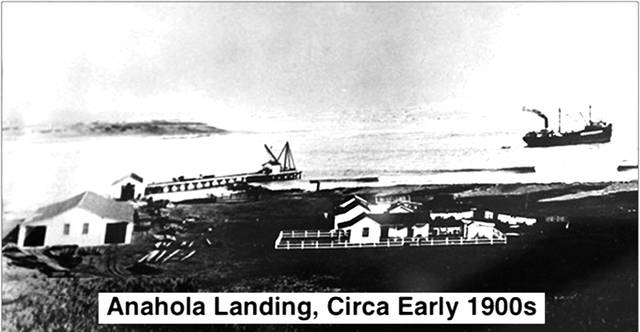A boat landing had existed at Kapaa prior to 1877, when Makee Sugar Company was established and built its first sugar mill in Kapaa a short distance north of this landing.
The Kapaa boat landing — once located where today’s Moikeha Canal empties into the ocean — was then improved and utilized by Makee Sugar Co. to ship its sugar off-island and to receive cargo.
Kapaa Landing was considered to be one of the most difficult landings in the Islands, since it was situated on an exposed coast and could only be reached by a channel through the reef so narrow that even a small steamer had barely enough room to thread its way through in only the calmest weather.
Open boats called lighters were consequently required to transfer cargo between the pier and vessels anchored outside the reef.
In 1884, Makee Sugar Co. dismantled its Kapaa Mill and moved it to Kealia, but continued to use Kapaa Landing, which was linked to Kealia by railroad.
Then in 1899, Makee built a landing at Anahola — also joined to Kealia by rail — where manager Fairchild reckoned that ships could tie at a pier while loading and unloading, but Anahola Landing also proved to be unsatisfactory, since it was open to heavy swells, making it sometimes impossible for large vessels to moor at its pier, and necessary that lighters be employed.
Anahola Landing was dismantled in 1914 and demolished in 1920, so that only its pier pilings remain today, and Kealia Landing and breakwater, built by Makee Sugar Co. in 1908, was also inadequate.
Makee Sugar Co. was therefore often compelled to haul its sugar overland for shipment at the more reliable Nawiliwili Landing, which Peirce Plantation, renamed Lihue Plantation, had built near Kalapaki Beach in 1849.
In 1920, when Ahukini Landing was built, Kauai finally possessed a port where inter-island vessels could safely tie directly to shore.
Port operations continued at Ahukini until 1950, although the bulk of Kauai’s eastside cargo passed through Nawiliwili Harbor after its construction was completed in 1930.


